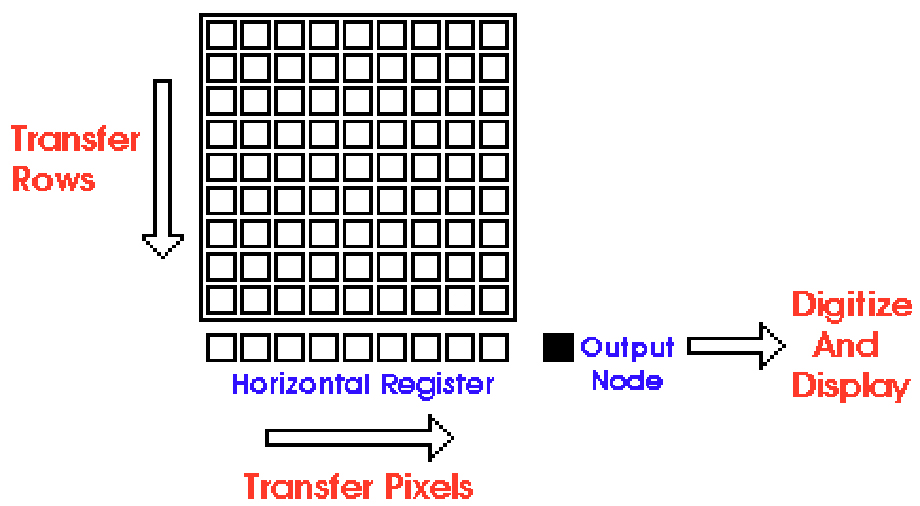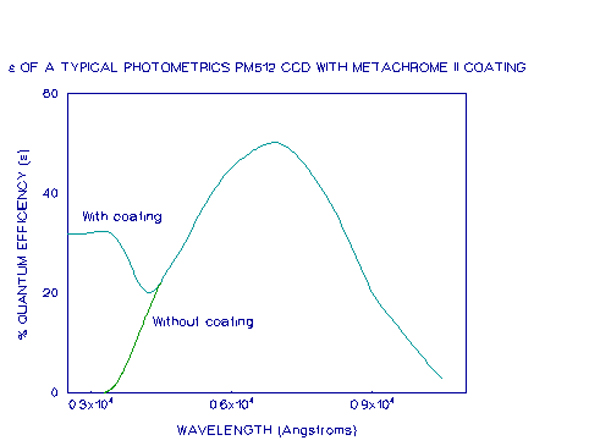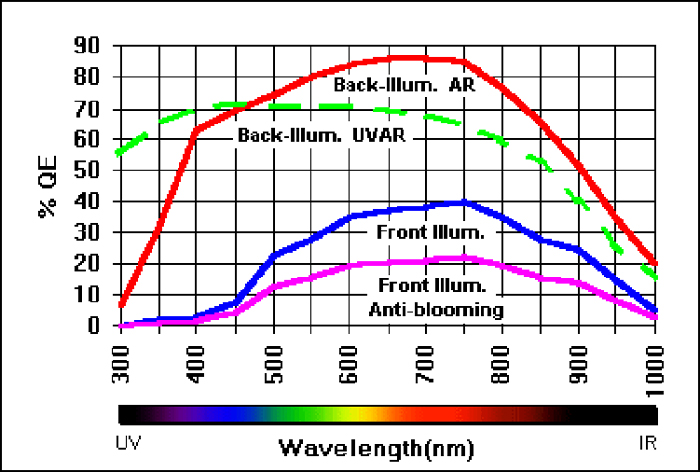
In a CCD, each of the pixels is coupled to its neighbours along the rows of the chip. The accumulated charge in each pixel is read out by transferring the charge of each pixel along the row to the end where a series of registers consisting of a MOS capacitor and amplifier are located. In this way the stored charge is transferred to the registers a column at a time. These output registers are then read out one at a time by an output amplifier until they are all read and then another column is read into the registers. This process continues until the entire array has been read.

The output amplifier converts the charge into a voltage which is converted into a numerical value by an analogue to digital converter.
Thus what the observer obtains as output from the CCD is a series of numbers in analogue to digital units (ADUs) which bear a direct relationship to the object's brightness and which are in a form readily manipulated by a computer.
Being a silicon based system, the CCDs are sensitive to much longer wave-lengths than photomultipliers. However, unless the chip is thinned and reverse illuminated so that the light passes through the silicon first rather than through the metal electrodes, or has been given a special phosphor coating, the chip has very poor blue sensitivity in the blue region of the spectrum. At the time, the CCD being used by the Perth Observatory had a response of essentially 0 at wavelengths shorter than about 3750 Å, as illustrated below.

In the time since this work was conducted, technology has considerable improved and so now it is possible (with a big enough wallet!!!!) to obtain CCD's that work well into the UV as shown in the graph below.

One of the biggest advantages of using a CCD for photometry is in the investigation of crowded fields, for example, dense regions of the Milky Way and globular clusters. A number of observers have produced numerous papers dealing with CCD photometric observations of southern globular clusters, for example Walker from South Africa. In such a situation, a single CCD image may contain dozens of stars which may be analysed simultaneously by a computer package such as DAOPHOT. Even stars whose images partly overlap may be successfully analysed. The saving in observing time can be considerable and stars can be studied that would be unobservable with a photomultiplier, where each star has to be sufficiently isolated to appear alone in the field of view of the photomultiplier.
For faint stars observed under these conditions precisions of 0.003-0.007 magnitudes have been reported. It is interesting to note however that Massey et al, after a thorough analysis of about 300 standard-star observations, would not claim an accuracy for their observations of better than 0.02 magnitudes. Much depends on the nature of the region. Crowded regions give less precise results. Also, what type of error is being described? While a set of observations may be internally consistent to 0.003 magnitude, the standard stars themselves can have errors of up to 0.005 magnitudes.
On the surface, photometry of a celestial object would seem to be a simple and straightforward procedure. All one has to do is to measure the amount of incoming light and then relate that measurement to the magnitude scale to derive the object's brightness. Unfortunately, as is usual in science, things are not this simple. Much of the problems associated with CCD photometry come from the considerable amount of pre-processing that the images require before they can be used. One of the first researchers to investigate these problems was Djorgovski in 1984 and his paper is still frequently referenced in discussions on pre-processing. Details of these pre-processing steps are contained in the next section.
Fransden et al draw attention to the need to position an object in the same region of the CCD chip when multiple observations of one object are made. Their observations showed a variation of ± 0.04 magnitudes when an object was allowed to "wander" around the chip from night to night.
Added note: The CCD used in this project was cooled to around 80K with liquid nitrogen. Under these circumstances, dark current is essentiality zero, so no dark frames were required. Most amateur grade CCDs do not have this luxury, so dark frame subtraction is required.)
2.3.1.Bias Subtraction
Before an image can be used for photometry it requires a considerable amount of pre-processing to reduce and calibrate it. The first of these preprocessing steps is bias-subtraction. All CCD chips have what is known as a bias voltage applied to them to prevent the voltage ever dropping below zero as this would damage the chip. This bias must be subtracted from all images. The usual method of obtaining a bias image is to take a 0 second exposure with the shutter closed so no light is falling on the chip. The resulting image will then show only the bias voltage applied to each pixel. Four to six of these images are obtained at the commencement of the observing session; they are then averaged to find a mean image. This lessens the effects of random fluctuations in the bias voltage. It is also usual to take further bias images during the night in case of variations.
2.3.2.Flat-Fielding
Once the bias has been subtracted, the next step is to compensate for variations in the pixel sensitivity, known as "flat-fielding". This step is necessary because no matter how well manufactured, CCD chips always have subtle variations in pixel sensitivity across the chip. As Mackay has succinctly put it, "the only uniform CCD is a dead CCD". These variations can arise from several sources, the most important being variations in optical transmission, quantum efficiency variations, and dust in the optical path.
There are several ways of obtaining flat-field images. Each method has its supporters and detractors, and there appears to be no consensus as to which technique is preferable, if any. Each technique is aimed at satisfying two conditions: (1) to provide a uniform illumination of the CCD to a level of up to 1 part in 1,000, and (2) to provide a light distribution over the bandwidth of the filter that is the same as the object being observed, to avoid any quantum efficiency variations that are wave-length dependent. In the words of R. Gilliland, "The first point is difficult enough to satisfy, the second is essentially impossible to satisfy in general for broadband photometry".
The first method of producing flat-fields is to illuminate the inside of the dome or a whiteboard, floodlit with filtered lamps, to obtain a correct colour balance. Massey and Jacoby indicate that dome flats are generally used at Kitt Peak Observatory and their paper contains a recipe for a truly white paint plus several suggestions for making the screen and for obtaining the correct colour balance of the lamps, which is one of the biggest difficulties with this method.
A second very common method is to take images of the twilight sky through each filter. Here the difficulties are to ensure there are no bright stars in the field and the relatively short period during which it is possible to take such images. Djorgovski also comments that twilight flats are "far too blue to be useful in most applications". Walker and Mach indicate that at the South African Astronomical Observatory twilight flats are used, while at the Cerro Tololo Intra-American Observatory, both twilight and dome flats are used.
The third method is to use the night sky. In this method a number of images of a region of the night sky, free from bright objects, are obtained. Each image is slightly offset from the previous image. These offsets enable faint stars to be detected as above average pixel counts moving in tandem with the offsets. These pixels are then masked and the images rescaled to a common median pixel count value. These rescaled images are then compared pixel by pixel to derive a median ADU count for each pixel, which is then taken as the value for the sky. The image produced by these median pixel values can then be used as the flat-field. This process is called median filtering and is the method favoured by Djorgovski. While this method does produce flat-fields which match exactly the colour term for the sky background of the images, it does have the major disadvantage of requiring long exposures to produce a high signal/noise ratio which can significantly reduce observing time.
Mackay concludes, "that flat-fielding is at best a compromise" but that "with careful flat-fielding it is possible to reduce these (non-uniformities) to 0.3-0.5% rms". Whichever method is used, a number of images are obtained with each filter and after bias-subtraction, are averaged and then scaled to a mean of 1. Once this is done the object image is simply divided by the flat-field image.